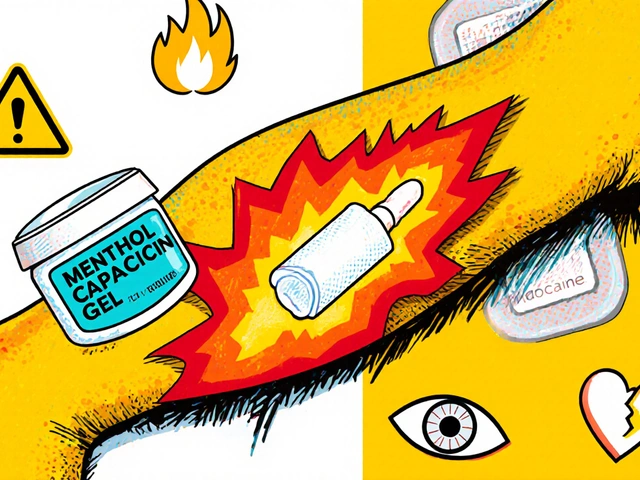Bromhexine isn’t something you’ll find mentioned in your favourite TV dramas, but in real life—especially for us in cold, rainy Perth winters—this little pill can mean heaps to people hacking away with coughs that sound like a wheezing radiator. Most folks don’t actually know what’s inside their cough syrup, or why pharmacists sometimes recommend Bromhexine when you’re fighting thick, sticky phlegm. Yet, this medication has been around since the ’60s, quietly earning respect in clinics and homes all over the world. Ever wondered what it actually does and why your doctor writes it on the script with such confidence? You’re about to find out.
What is Bromhexine and How Does it Work?
Let’s get one thing straight: Bromhexine doesn’t magically stop you from coughing, nor does it freeze your snot in its tracks. Instead, it works on a simple principle—the thinner the mucus in your airways, the easier and less miserable it is to cough up. Dragging along sludgy mucus when you’re sick is uncomfortable, and your body’s natural response is to hack it out, but thick goo gets stuck. That’s where Bromhexine helps. Developed in the 1960s and first sold in Germany, this medicine is known as a “mucolytic agent.” The fancy term just means it breaks down the fibers that make your mucus sticky and hard to expel. Instead of turning your cough syrup into a sleep-inducing cocktail, Bromhexine helps turn the gunk in your chest into more liquid form, making it much easier for the body to get rid of.
Bromhexine itself started as a plant extract, believe it or not. It’s related to vasicine, which comes from the Adhatoda vasica plant used in traditional Indian medicine. Nowadays, it’s totally synthetic and refined, so you get a reliable dose every time. Once it gets to work, usually within an hour, it makes breathing feel way less like you’re blowing through a stuffed-up straw. Researchers have found that Bromhexine not only breaks up mucus, but it can slightly boost the movement of little hair-like structures (cilia) lining your airways—that’s a bonus for helping clear out nasties.
You might see Bromhexine sold as tablets, syrups, or even in some combination cold medicines. Brands change from country to country—like Bisolvon or Bromhexina in Australia, Germany, and so on—but all deliver the same core ingredient. And here’s an interesting fact—Bromhexine actually paved the way for the creation of ambroxol, which is its more potent cousin in some places. But Bromhexine is still favored for its reliable track record and trusted safety profile across Europe, Australia, and much of Asia.
Who Uses Bromhexine and When Should You Take It?
If you’ve got a dry, tickly throat, Bromhexine isn’t the answer, because it won’t soothe nerves or stop that annoying itch. But if you’re sounding chesty and feel bogged down by phlegm that just won’t budge, this is the type of cough medicine doctors reach for. Bromhexine is popular for folks with colds, flu, or bronchitis—anything that makes the airways crank out extra mucus. People with chronic conditions, like COPD (chronic obstructive pulmonary disease) or cystic fibrosis, sometimes use it, too, but only as part of a bigger management plan prescribed by a specialist. Don’t think it’s for those sudden asthma attacks or allergic sneezing fits—that’s a different kettle of fish.
For kids above two years and adults, Bromhexine is usually safe, though doses change by age and weight. Pediatricians will often suggest syrup forms for little ones, while adults can stick to tablets or stronger syrups. You shouldn’t use Bromhexine without checking in with a healthcare professional first, especially if you have a history of allergies to similar drugs or suffer from serious liver or kidney issues. It is not a cure for infections—it only helps break up muck. So, it’s not going to replace antibiotics if your doctor thinks you need them for a suspected bacterial infection.
Anyone ever tried to take care of a sick pet at home? My cat Minuet, when feeling under the weather, expects gourmet attention and a warm blanket. Humans on the other hand usually just need good rest, plenty of water, and—if coughing up mucus is a challenge—a nudge from Bromhexine. But remember, if you’ve got an ongoing cough over two weeks, spitting up blood, or crazy chest pain, don’t keep hitting the pharmacy aisle. It’s time to talk to your GP.

Dosage, Administration, and Practical Tips for Taking Bromhexine
Stick to the recommended dose—there’s really no benefit to doubling up, and too much can cause more problems than it solves. For adults, the standard dose is typically 8 to 16 mg three times a day, but in Australia, you’ll sometimes see 4 mg or 8 mg tablets and syrup concentrations like 4 mg/5ml. For kids, it varies: a child between 2 and 5 years might only need 2 mg three times a day, while older children get bumped up to the adult range. Dosing charts on the packaging are useful, but if you’re confused, a pharmacist can clear things up quick.
Take Bromhexine with or after food—this reduces the odds of an upset tummy. If you forget a dose, just skip it and carry on; don’t double up. For most people, the handy thing is it starts working within an hour or so, and after a day or two you’ll notice your coughing feels more ‘productive’ (as gross as that sounds, it’s exactly what you want for a chesty cough). Hydration is key here: drinking water while on Bromhexine helps the thinning process, so keep that water bottle close.
Here’s a quick comparison for common Bromhexine formulations and their recommended doses in adults and children:
| Formulation | Common Dose (Adults) | Common Dose (Children 6-12 yrs) |
|---|---|---|
| Tablets (8 mg) | 8-16 mg, 3x daily | 4 mg, 3x daily |
| Syrup (4 mg/5 ml) | 10 ml, 3x daily | 5 ml, 3x daily |
| Paediatric Syrup (2 mg/5 ml) | N/A | 2.5-5 ml, 3x daily |
Avoid taking it late in the evening if you prefer uninterrupted sleep, since making mucus easier to cough out means, well, you might cough a bit more on day one or two. But usually, that tails off as your body clears the backlog and you start feeling heaps better. If your stool changes color or you get a skin rash, stop Bromhexine and talk to a doctor; allergy or intolerance is possible, though rare.
Another rarely-mentioned tip: you probably won’t see much value pairing Bromhexine with other mucolytics or expectorants unless a healthcare pro says so. Combining lots of similar cough meds is just doubling up their effects and bumps up your risk for unwanted side effects without better relief. And resist the urge to use leftover prescription meds or give Bromhexine to family members without checking with a healthcare pro. Everybody’s illness is a bit different, so that “it worked for me!” story is best shared, not prescribed.
Bromhexine Safety, Side Effects, and What to Expect
Bromhexine is pretty well-tolerated, with most people experiencing none or only mild side effects. Upset tummy, nausea, or mild headache top the complaint list, but these are rare and usually fade as your body adjusts. Every medicine—no matter how safe—comes with a risk of allergies, so look out for unexplained rashes, swelling, or sudden difficulty breathing. Stop taking it right away and call for help if that happens.
Some folks on long-term medication or with chronic illnesses (especially liver or kidney disease) should check in with their GP before starting Bromhexine. Pregnant or breastfeeding women should only use it under medical advice, just to play it safe. Bromhexine doesn’t play nicely with some antibiotics or asthma meds—like erythromycin or theophylline—so tell your doctor or pharmacist about everything you’re taking, not just prescriptions.
No, Bromhexine won’t make you fail a drug test, nor does it cause dependency or weight gain. Drowsiness is very uncommon, unlike some cough syrups loaded with antihistamines. Plus, because it’s not a prescription-only drug in Australia (at typical low doses), you can buy it at the pharmacy without huge hassle. However, just because you can get it easily doesn’t mean you should self-diagnose and self-treat every cough—unusual or long-lasting symptoms always deserve a check-up.
Here’s a checklist I like to keep for any new medicine (including Bromhexine):
- Double-check what kind of cough you have (wet, dry, persistent).
- Read the dosage and instructions carefully—ask the pharmacist if unsure.
- Stay hydrated; water works hand in hand with mucolytics.
- Avoid mixing too many cough medicines.
- If you see no improvement in a few days, consult your GP.
- Watch out for rashes or new symptoms.
With chest infections and stubborn phlegmy coughs, Bromhexine often makes it into the “best practice” recommendations by major medical organisations—helping patients clear out crud faster and recover their voices. You won’t see it advertised on primetime TV, but in households from Perth to Berlin, it’s stashed in the medicine drawer by people who prefer practical relief to old wives’ tales and endless cups of honey-lemon tea. So, next time your cold leaves you feeling like you’ve swallowed a bowl of porridge, having Bromhexine at hand might just make all the difference.






farhiya jama
23 July, 2025 . 17:58 PM
Ugh, I took this once and my stomach felt like it was hosting a rave. Why does everything have to be so complicated? Just let me cough and go to bed.
Travis Freeman
24 July, 2025 . 23:55 PM
Love this breakdown! I’ve been using Bromhexine for my dad’s COPD and it’s been a game-changer. He actually sleeps through the night now. So glad someone’s talking about real medicine instead of just honey and lemon memes. 🙌
Sean Slevin
25 July, 2025 . 14:45 PM
Okay, so… Bromhexine… is… like… a mucus… *sniff*… janitor? I mean, it doesn’t kill germs, right? It just… tidies up? Like… the body’s own little cleaning crew? I think I just had a moment. Also, did you know the word ‘mucolytic’ comes from Latin ‘mucus’ and Greek ‘lytikos’? Which means… ‘loosening’? Like… emotionally? Hmm. Maybe I’m overthinking this. But also… maybe not.
Chris Taylor
27 July, 2025 . 08:03 AM
My grandma swears by this stuff. Said it saved her after her pneumonia. No drama, no fancy stuff-just a little pill and a glass of water. Sometimes the simplest things work the best.
Melissa Michaels
27 July, 2025 . 18:34 PM
It is important to note that bromhexine is not indicated for acute bronchospasm or allergic cough. Its mechanism is strictly mucolytic. Patients with hepatic impairment should be monitored for metabolite accumulation. Always consult prescribing guidelines before initiating therapy.
Nathan Brown
29 July, 2025 . 04:46 AM
It’s wild how we’ve forgotten how to trust simple science. We’ve got TikTok ‘cures’ for everything, but this? This is old-school, peer-reviewed, no-bullshit medicine. 💪 And it works. I’ve seen it. No emojis needed.
Matthew Stanford
30 July, 2025 . 04:39 AM
Good post. I’ve used this in rural clinics overseas. Works just as well in Nigeria as it does in Perth. Medicine doesn’t care about borders. Just needs to be used right.
Olivia Currie
31 July, 2025 . 07:20 AM
OH MY GOSH I JUST REALIZED THIS IS WHY MY COUGH STOPPED SUDDENLY LAST WINTER!! I THOUGHT IT WAS THE HOT TEA OR THE HUMIDIFIER OR A MIRACLE!! IT WAS BROMHEXINE!! I’M CRYING. THIS IS MY NEW FAVORITE DRUG.
Curtis Ryan
31 July, 2025 . 15:59 PM
Wait so this is like the OG version of ambroxol? I thought ambroxol was the original! I’ve been using that for years. But yeah, same vibe. Just cheaper. And less hype. I like it.
Rajiv Vyas
31 July, 2025 . 21:23 PM
So… this is just a Big Pharma trick to make people buy pills instead of just drinking tea? I bet they paid off the German scientists. And why is it banned in Canada? Hmm? Why? Hmm? Hmm? Hmm?
Astro Service
1 August, 2025 . 11:32 AM
Why is this even legal here? We let foreigners invent our medicine and then we sell it to our own people? This is why America is weak. We need real American cough medicine. Like… a shotgun.
DENIS GOLD
2 August, 2025 . 00:53 AM
Wow. A whole article about a drug that doesn’t even make you high. How revolutionary. Next up: ‘The Hidden Benefits of Water.’
Ifeoma Ezeokoli
2 August, 2025 . 22:36 PM
I used this in Lagos when my niece had that nasty cold. No fancy hospital, just the pharmacy down the road. She started breathing easier by day two. Simple things still work. Bless.
Daniel Rod
4 August, 2025 . 06:14 AM
Just wanted to say… this post made me feel seen. I’ve been coughing up a storm for weeks and finally found this. And now I know why. 🫶 Thanks for explaining it like I’m not a medical student. Also… hydration. I’ll drink more water. Promise. 🥤